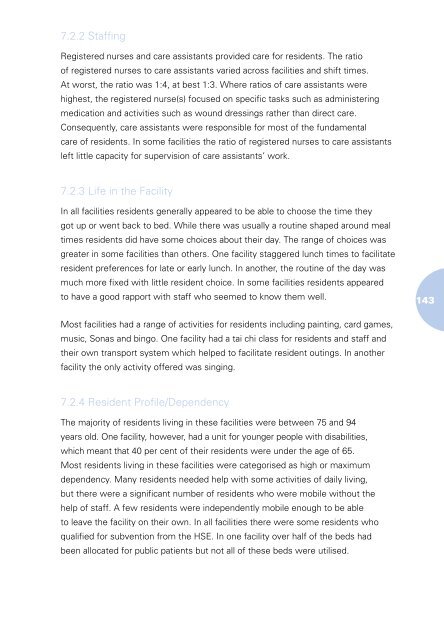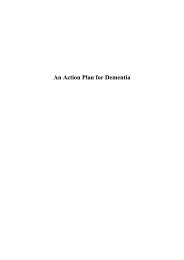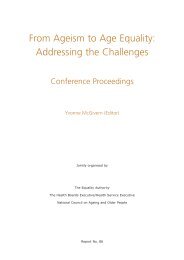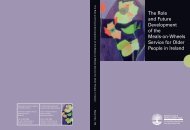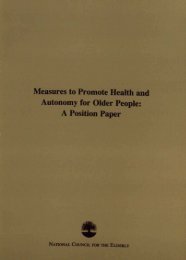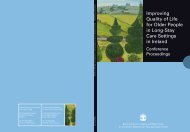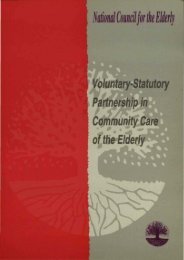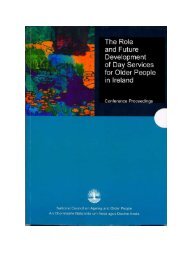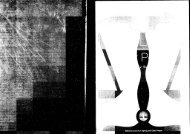Improving Quality of Life for Older People in Long-Stay Care ...
Improving Quality of Life for Older People in Long-Stay Care ...
Improving Quality of Life for Older People in Long-Stay Care ...
- No tags were found...
Create successful ePaper yourself
Turn your PDF publications into a flip-book with our unique Google optimized e-Paper software.
7.2.2 Staff<strong>in</strong>gRegistered nurses and care assistants provided care <strong>for</strong> residents. The ratio<strong>of</strong> registered nurses to care assistants varied across facilities and shift times.At worst, the ratio was 1:4, at best 1:3. Where ratios <strong>of</strong> care assistants werehighest, the registered nurse(s) focused on specific tasks such as adm<strong>in</strong>ister<strong>in</strong>gmedication and activities such as wound dress<strong>in</strong>gs rather than direct care.Consequently, care assistants were responsible <strong>for</strong> most <strong>of</strong> the fundamentalcare <strong>of</strong> residents. In some facilities the ratio <strong>of</strong> registered nurses to care assistantsleft little capacity <strong>for</strong> supervision <strong>of</strong> care assistants’ work.7.2.3 <strong>Life</strong> <strong>in</strong> the FacilityIn all facilities residents generally appeared to be able to choose the time theygot up or went back to bed. While there was usually a rout<strong>in</strong>e shaped around mealtimes residents did have some choices about their day. The range <strong>of</strong> choices wasgreater <strong>in</strong> some facilities than others. One facility staggered lunch times to facilitateresident preferences <strong>for</strong> late or early lunch. In another, the rout<strong>in</strong>e <strong>of</strong> the day wasmuch more fixed with little resident choice. In some facilities residents appearedto have a good rapport with staff who seemed to know them well.143Most facilities had a range <strong>of</strong> activities <strong>for</strong> residents <strong>in</strong>clud<strong>in</strong>g pa<strong>in</strong>t<strong>in</strong>g, card games,music, Sonas and b<strong>in</strong>go. One facility had a tai chi class <strong>for</strong> residents and staff andtheir own transport system which helped to facilitate resident out<strong>in</strong>gs. In anotherfacility the only activity <strong>of</strong>fered was s<strong>in</strong>g<strong>in</strong>g.7.2.4 Resident Pr<strong>of</strong>ile/DependencyThe majority <strong>of</strong> residents liv<strong>in</strong>g <strong>in</strong> these facilities were between 75 and 94years old. One facility, however, had a unit <strong>for</strong> younger people with disabilities,which meant that 40 per cent <strong>of</strong> their residents were under the age <strong>of</strong> 65.Most residents liv<strong>in</strong>g <strong>in</strong> these facilities were categorised as high or maximumdependency. Many residents needed help with some activities <strong>of</strong> daily liv<strong>in</strong>g,but there were a significant number <strong>of</strong> residents who were mobile without thehelp <strong>of</strong> staff. A few residents were <strong>in</strong>dependently mobile enough to be ableto leave the facility on their own. In all facilities there were some residents whoqualified <strong>for</strong> subvention from the HSE. In one facility over half <strong>of</strong> the beds hadbeen allocated <strong>for</strong> public patients but not all <strong>of</strong> these beds were utilised.


